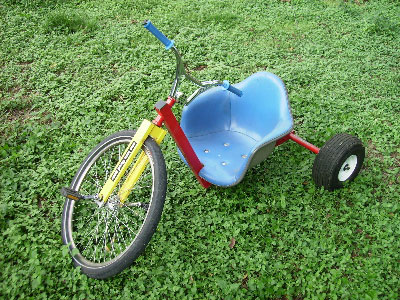tigcross
100 W
Hi Guys,
I’ve been meaning to get something up in “The Sphere” for awhile. I’ve been observing for ever and have had a few helpful bits of advice from Justin so I figure it’s time to share what I’ve learned.
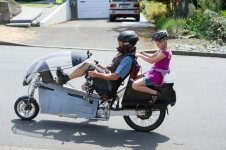 View attachment 5
View attachment 5
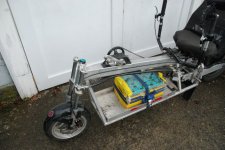
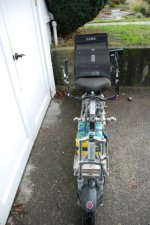
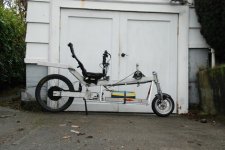

My bike:
It’s a long-wheelbase recumbent bike/motorbike built from scratch. This is version 3.2
The fork and front wheel is from a cheep pocket bike (an X18).
The back wheel is a Crystalite Crown 100 in a 24” rim, running on 72 volt with a Lyen 18 fet controller and Cycleanylist V3.
Batteries are 24 GBS 20 AH cells with GBS’s simple shunt based BMS. After charging my resting voltage is 81.5. Depending on how I ride I can usually get to 70 KM on a charge(I’m very exited to switch to a new high output 18650 based setup as soon as I can afford it).
Human energy goes via a Rolhoff 14 speed hub back to a single speed freewheel on the Crown.
I’m using a remote steer via pushrod and understeer configuration.
Frame is aluminum, other parts are plywood, foam and Carbon fibre.
The fairing is a Windwrap LWB. It pivots up and out of the way to get on and off.
Top speed is 83 KM on the flat, but I rarely go that fast unless I want to burn a whole bunch of battery quickly.
Observations:
I’ve been riding it in this configuration since November of 2014. So far I’ve put about 3100 Km on it. If I stay within bike legal limits of about 1000 watts and 32 kph I can get as much as 80 km range. But I usually ride it a 2500W and a top speed of 45kph. That seems to be it’s sweet spot where I feel like I’m getting somewhere and do not attract too much attention. As I keep the speed low most of the time and it has pedals, I've so far been able to pass for a recumbent bicycle and have not had to register it. (I do have lights and signals though). I think that when cops see anything recumbent go by they just think "there goes another of those weird recumbent bike fools, better not stop him he'll bore me to death with talk of superior drag coefficients..."
The basic concept is a recumbent motorbike that you can pedal if you feel like it, I find that I set the speed with the throttle and match my pedaling to it with the Rohloff (love the cruise control on the V3 for this reason.
My head is at about 48 inches off of the ground while riding, which makes for good visibility, I can see and be seen. I’m convinced that this is one of the best reasons to stick with two wheels instead of a trike configuration. If I tried to make a trike that high, I would have a terrible center of gravity and huge wind resistance. But with a two-wheeler these are not issues. Despite that height my frontal area is quite small. A note, when I put the fairing on, my efficiency at speeds over 40kph went noticeably up. On the same flat stretch of road I could go 40 kph using 1000W instead of 1300W
It handles great at all speeds, and is surprisingly stable at 80 kph. It is also very comfortable and easy to get on and off of. I notice that if I lift my back off of the seatback it handles a lot like skiing, in that you move the bike beneath you while pivoting at the hips and your upper body stays vertical. The head angle is too steep though, I will change that on the next version.
The under steer configuration is (in my opinion) the only way for long-wheelbase bikes. It allows for easy on-and-off, does not have an impaling issue, is super comfortable, and eliminates the whole issue of handlebar placement vs pedaling that haunts long-wheelbase recumbents.
With the fairing and back cargo pod It does present a large side area to crosswinds, but I find it is stable and heavy enough to handle everything I’ve encountered so far.
It is a great highway machine but also quite nimble in the city. I have the power to take a lane in traffic, and as most city traffic rarely gets above 40 kph where I live, I haven’t attracted any unwanted attention (fingers crossed). I've set it up to carry kids and cargo, and use it around town quite a bit. I get a lot of comments but few people understand what it actually is.
An electric recumbent solves some inherent issues with recumbents and electric bikes. The ability to start up under electric power and then sort your pedaling out makes starting up easier, and the recumbent position allows for all of the battery weight and bulk to be kept super low. I have about 25 litres of usable battery space that is 8 inches off of the ground.
The Crown is far more powerful than I usually need, but I guess when I get some batteries with a lot more jam it will be nice. And I never have to worry that I am overpowering it. My next build will use a smaller diameter back wheel as I’d rather have the torque than the top speed.
I did crash it this summer, and it went down very nicely. I slid out on some gravel at about 40 kph. I got a good bit of road rash on my thigh and forearm but otherwise the crash was pretty manageable. I think it is kind of obvious that as we get up to these speeds we need to invest in motorcycle style protection. It is also inescapable that recumbent position bikes do not handle gravel the same or nearly as well as upright bikes. That combined with the head-whipping issues of a recumbent makes them completely unsuitable for off-road.
This bike uses the human energy directly via Rohloff transmission and chain, but my previous version used a separate generator system that took the human energy and put it into the system as electricity. It was less efficient, but very nice to use, one could pedal at a constant cadence regardless of speed or terrain (or while stopped). It also greatly simplifies the chain-line issues of getting pedaling energy to the back wheel. My concept is this: if you are sitting around on electric vehicle you might as well get some exercise.
Intended Changes:
I’ve taken this frame about as far as I intend to design wise, and learned a lot. My next frame will have:
Lower stand-over height
A pedal-to-generator system
A smaller back wheel.
A Sine Wave controller
I’m looking forward to hearing back from the community, thanks in advance for your advice/observations.
I’ve been meaning to get something up in “The Sphere” for awhile. I’ve been observing for ever and have had a few helpful bits of advice from Justin so I figure it’s time to share what I’ve learned.
 View attachment 5
View attachment 5




My bike:
It’s a long-wheelbase recumbent bike/motorbike built from scratch. This is version 3.2
The fork and front wheel is from a cheep pocket bike (an X18).
The back wheel is a Crystalite Crown 100 in a 24” rim, running on 72 volt with a Lyen 18 fet controller and Cycleanylist V3.
Batteries are 24 GBS 20 AH cells with GBS’s simple shunt based BMS. After charging my resting voltage is 81.5. Depending on how I ride I can usually get to 70 KM on a charge(I’m very exited to switch to a new high output 18650 based setup as soon as I can afford it).
Human energy goes via a Rolhoff 14 speed hub back to a single speed freewheel on the Crown.
I’m using a remote steer via pushrod and understeer configuration.
Frame is aluminum, other parts are plywood, foam and Carbon fibre.
The fairing is a Windwrap LWB. It pivots up and out of the way to get on and off.
Top speed is 83 KM on the flat, but I rarely go that fast unless I want to burn a whole bunch of battery quickly.
Observations:
I’ve been riding it in this configuration since November of 2014. So far I’ve put about 3100 Km on it. If I stay within bike legal limits of about 1000 watts and 32 kph I can get as much as 80 km range. But I usually ride it a 2500W and a top speed of 45kph. That seems to be it’s sweet spot where I feel like I’m getting somewhere and do not attract too much attention. As I keep the speed low most of the time and it has pedals, I've so far been able to pass for a recumbent bicycle and have not had to register it. (I do have lights and signals though). I think that when cops see anything recumbent go by they just think "there goes another of those weird recumbent bike fools, better not stop him he'll bore me to death with talk of superior drag coefficients..."
The basic concept is a recumbent motorbike that you can pedal if you feel like it, I find that I set the speed with the throttle and match my pedaling to it with the Rohloff (love the cruise control on the V3 for this reason.
My head is at about 48 inches off of the ground while riding, which makes for good visibility, I can see and be seen. I’m convinced that this is one of the best reasons to stick with two wheels instead of a trike configuration. If I tried to make a trike that high, I would have a terrible center of gravity and huge wind resistance. But with a two-wheeler these are not issues. Despite that height my frontal area is quite small. A note, when I put the fairing on, my efficiency at speeds over 40kph went noticeably up. On the same flat stretch of road I could go 40 kph using 1000W instead of 1300W
It handles great at all speeds, and is surprisingly stable at 80 kph. It is also very comfortable and easy to get on and off of. I notice that if I lift my back off of the seatback it handles a lot like skiing, in that you move the bike beneath you while pivoting at the hips and your upper body stays vertical. The head angle is too steep though, I will change that on the next version.
The under steer configuration is (in my opinion) the only way for long-wheelbase bikes. It allows for easy on-and-off, does not have an impaling issue, is super comfortable, and eliminates the whole issue of handlebar placement vs pedaling that haunts long-wheelbase recumbents.
With the fairing and back cargo pod It does present a large side area to crosswinds, but I find it is stable and heavy enough to handle everything I’ve encountered so far.
It is a great highway machine but also quite nimble in the city. I have the power to take a lane in traffic, and as most city traffic rarely gets above 40 kph where I live, I haven’t attracted any unwanted attention (fingers crossed). I've set it up to carry kids and cargo, and use it around town quite a bit. I get a lot of comments but few people understand what it actually is.
An electric recumbent solves some inherent issues with recumbents and electric bikes. The ability to start up under electric power and then sort your pedaling out makes starting up easier, and the recumbent position allows for all of the battery weight and bulk to be kept super low. I have about 25 litres of usable battery space that is 8 inches off of the ground.
The Crown is far more powerful than I usually need, but I guess when I get some batteries with a lot more jam it will be nice. And I never have to worry that I am overpowering it. My next build will use a smaller diameter back wheel as I’d rather have the torque than the top speed.
I did crash it this summer, and it went down very nicely. I slid out on some gravel at about 40 kph. I got a good bit of road rash on my thigh and forearm but otherwise the crash was pretty manageable. I think it is kind of obvious that as we get up to these speeds we need to invest in motorcycle style protection. It is also inescapable that recumbent position bikes do not handle gravel the same or nearly as well as upright bikes. That combined with the head-whipping issues of a recumbent makes them completely unsuitable for off-road.
This bike uses the human energy directly via Rohloff transmission and chain, but my previous version used a separate generator system that took the human energy and put it into the system as electricity. It was less efficient, but very nice to use, one could pedal at a constant cadence regardless of speed or terrain (or while stopped). It also greatly simplifies the chain-line issues of getting pedaling energy to the back wheel. My concept is this: if you are sitting around on electric vehicle you might as well get some exercise.
Intended Changes:
I’ve taken this frame about as far as I intend to design wise, and learned a lot. My next frame will have:
Lower stand-over height
A pedal-to-generator system
A smaller back wheel.
A Sine Wave controller
I’m looking forward to hearing back from the community, thanks in advance for your advice/observations.





